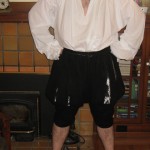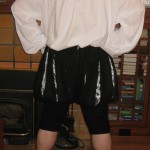One random thing I do is make up dorky songs. Mostly these get sung to the critters, but sometimes they are sewing-related. This is relevant because I came up with a song about “ham pants,” and thus Michael’s trunkhose got their name. (Okay, they were Ood Pants for a while, because the panes were very tentacle-y, but now they’re Ham Pants).
So, uh, yeah, I’ve worked on these. A LOT! Boy clothes are boring, I have decided. Although I am having crazy thoughts of making some super over the top 18th century man’s outfit for myself and cross-dressing, just because 18th c. men’s clothing is fab and when will I ever have a chance to make it? But now I am off topic.
So I made Michael’s shirt a loong while ago, working from the Tudor Tailor book. All very easy, rectangular construction, except for the fact that the collar was about .5″ too small, so I cut a new one and somehow brilliantly cut it even SMALLER, so ended up making/attaching the collar 3 times. Someday it will get ties at the neck and cuffs. It will probably never get a hem (hey, I often leave my shifts unhemmed, so it’s standard practice!).
But the trunkhose were made using the Tudor Tailor sized patterns, which are EXPENSIVE given the exchange rate. They really need a US supplier!
And let me tell you about this pattern. It was drafted very nicely — all the pattern pieces matched up and went together. Fitting the pants was relatively easy, as it was just a matter of fitting the fitted lining, then extending the length on the various pattern pieces to match (my husband is 6’5″).
BUT:
1. The pattern sheets are HA-UGE. I mean seriously, ridiculously, crazy huge. I took a picture to show you how it basically covered 1/2 of the square footage of my sewing room, but I seem to have lost it. It made tracing off the various pieces a serious pain. Luckily the doublet is on one sheet, and the trunkhose on two, so it’s not that crazy Simplicity hunt for a tiny piece on a random sheet. But DUDE, that’s a seriously big piece of paper.
2. Even more importantly, THE INSTRUCTIONS SUCK. The pattern instructions included with the (scaled, not the book) pattern are exactly the same ones as in the book. I first looked at them and though, “Eh, no problem. I’m a pretty decent seamstress, and I don’t usually bother to follow pattern instructions anymore (when I bother to use patterns).” But this was my first time sewing this garment, and I admit I needed a bit of guidance. Now, yes I could have gone and read every bit of Janet Arnold and scoured the web, but I don’t think I should NEED to do this in order to make up your pattern.
There are a few more photos vs. the book, but they are faded color copies and are hard to make out. One photo completely puzzled me until Teresa figured it out, explained it to me, AND I looked at it upside down. It still makes no sense when I look at it right side up.
Most importantly (and this goes for the book too): they tell you to do some things out of order. To wit, in case anyone else decides to make up this pattern from the scaled pattern or the book: Go ahead and put the darts in the trunkhose lining bottom, but do NOT gather and/or attach the trunkhose lining top to the waistband UNTIL you have figured out the panes length. Do what I did: attach the panes at the bottom of the trunkhose lining, then figure out the pane lengths, then gather/attach the trunkhose lining top to the waistband, then cartridge pleat the panes. Also, I have no idea if it’s because I was making a larger size, but I found that there really wasn’t much fabric to cartridge pleat in the panes. I mean, I had to gather them, yes, but they basically made waves rather than tight cartridge pleats. I doubt it’s period, but if I ever made these again, I would just do two rows of gathering stitches across all the tops of the panes, sew that to the waistband; then I would gather the trunkhose lining and hand sew it to the waistband/panes (I think it would be too thick to machine sew; you’ll have to handsew anyway if you cartridge pleat).
Some positives? Again, all the pattern pieces went together well. I would personally think about adding some balance marks, but hey, I didn’t need them.
One thing that could go either way: the patterns are drafted without seam allowance. This will be great if you work like me, where you make mockups and worry about the seamlines, perfect your pattern, and then add seam allowance — it saved me the step of removing the seam allowance before making a mockup. But I know that freaks some people out, so I thought I’d note it.
So, they are done, minus lacing holes. And the husband is super cute, because I put him into his shirt and Ham Pants to check that they were done, and then told him I was done, and he said, “Hey, don’t you have a blog where you post photos?” So he gets a gold star for volunteering to have dorky photos of himself wearing Ham Pants on the interwebs. Winston just walked right into the photo and sat very nicely for his portrait, so I had to include him too.
Yes, the Ham Pants(TM) are mostly black, so it’s hard to tell what’s going on here… but they’re done, and minus some loose cartridge pleating, I’d say they’re decently well made. And I am now SO over boys clothes, and really just want to work on my own stuff (which, I admit, I did last weekend… but more on that in another post!).


I was reading and scrolling down and then I got to the pics of Michael at the bottom and stopped reading to add this totally relevant and important comment:
HELLO HAM PANTS! RWAR!
Also, love the matching dog. And Michael’s “Dear God, I’m going to get every one of my wife’s crazy ass costumer friends leaving mortifying commentary concerning my ham pants” expression.
Ha! I know! He is going to look very Jeremy Irons in all this getup.
Wow, he’s so brave for letting the pictures escape onto the interwebs! Except, you know, I’m going to call them Oood pants & make the little hand signal when I see him. Can’t help myself.
Great job! I like the ham pants. And extra points for the handsome man who is willingly wearing them. Bonus for the cute dog, too.
Aaaaaah! That first picture is so cute! Something about the pooch and the pants is adorable and hilarious and I love it.
Nice ham pants! I wanna hear the song. Also, you should totally do 18th-c cross dressing. Embroidered waistcoats ahoy!
The ham pants look great! I’m working on a pair too but based on the Medici ones. Did you end up using the quilt batting for interlining as in the TT instructions, or did you end up leaving that off? I’m still undecided on how much oomph and body it might give if I use it as interlining.
Jenn — I did use the quilt batting, and I think you need it to keep the thing somewhat poufy (without being stuffed). Otherwise, I think they would collapse in on themselves constantly and look limp.
Can’t have limp ham pants.
Totally! B/c then they are Hamless Pants!
I think Winston needs a matching outfit. At least a ruff, since he’s so eager to be involved!
I love the pants! Thanks for the review on the Tudor Tailor patterns. I’m in slight shock that I paid almost $80 for a pattern with no seam allowances. I can figure it out, and like you I always to a mock-up anyway, but still…kinda lazy for such an expensive pattern.
Melissa – from what I know, it’s pretty standard practice on European patterns (like Burda). I think the logic is that when you’re doing mockups/fit, you should be worrying about the seamline itself and perfecting that, then add SA. And of course there are some sewers who mark all the seamlines in chalk and don’t worry about measuring SA!
Catherine: I keep threatening the same thing! I think Ham Pants would be hard, but a ruff…
I’m one of those who mark seamlines in chalk and don’t worry a bit about seam allowances. Patterns with seam allowances annoy me. I want to be able to make my seam allowances as big or as small as I want. Like, when I’m squeezing a pattern into much smaller piece of fabric than suggested. 🙂
Ham-some lookin’ pants! Nice work! 😀
The dog just slays me.